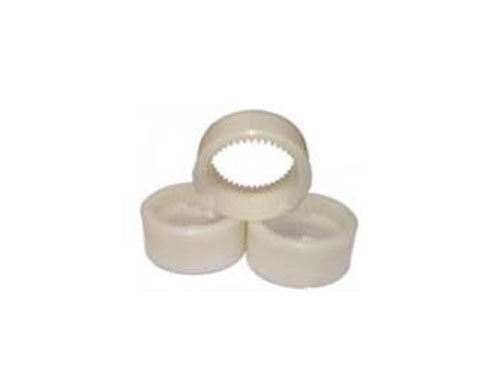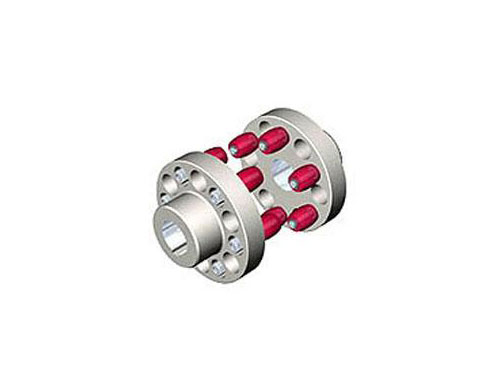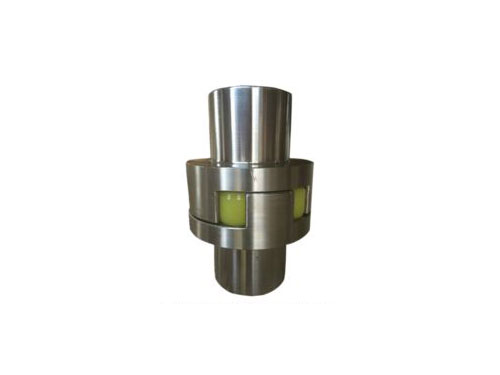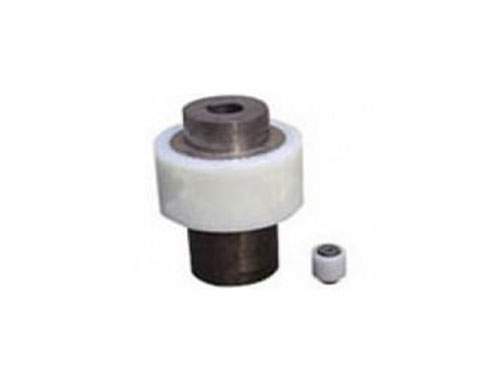 Nylon sleeve inner gear ringThe main purpose of the nylon sleeve inner gear ring is:...
Nylon sleeve inner gear ringThe main purpose of the nylon sleeve inner gear ring is:... HL type elastic pin couplingThe elastic pin coupling (GB5014-85) is suitable for...
HL type elastic pin couplingThe elastic pin coupling (GB5014-85) is suitable for... Three-jaw coupling for pumpThe three-jaw coupling for pumps uses a number of non...
Three-jaw coupling for pumpThe three-jaw coupling for pumps uses a number of non... ML plum-shaped elastic couplingML plum-shaped elastic coupling and other coupling...
ML plum-shaped elastic couplingML plum-shaped elastic coupling and other coupling... NL type drum gear couplingThe shaft hole types are cylindrical (Y), conical...
NL type drum gear couplingThe shaft hole types are cylindrical (Y), conical...The performance and processing method of drum gear coupling
The performance of the drum gear coupling requires it to have the ability to compensate the relative displacement of the two shafts, and the angular displacement of the two horizontal axis transmission shafts is ultimately reflected in a pair of meshing teeth. The allowable deflection angle depends on The size of the backlash between the meshing teeth.The choice of backlash is more critical.Considering that the gear coupling is different from the gear transmission, in terms of structure, a pair of internal and external gears are assembled together and rotate together at the same circumferential speed.There are different technical solutions for the development of drum-shaped gear couplings. The design method for calculating the tooth thickness of the TGII drum-shaped gear coupling according to the thickness of the internal and external teeth indexing circle has the following characteristics:
1. Angular compensation and backlash:
The design of the drum gear coupling is based on the allowable large angular compensation to determine the tooth profile parameters and the size of the backlash. The large angular compensation is also an important factor affecting the load-bearing capacity. The greater the angular compensation, the simultaneous work The less the number of teeth, the lower the transmission torque.The drum gear coupling allows the two coupling shafts to move in any direction, which is essentially an angular compensation amount. The inner gear ring and the outer gear shaft sleeve of the coupling constitute a special intersecting axial meshing pair transmission.And it has a good ability to compensate for the displacement of the two shafts in any direction. The TGII drum gear coupling designs the external tooth top as a spherical surface on the axis as a centering circle. The centering structure adopts the teeth of the inner ring gear. The root cylindrical surface is centered with the spherical surface of the outer tooth tip of the drum tooth, which matches H9/h7.
The gearing pair should determine the appropriate tooth backlash. Small backlash cannot meet the requirements of angular compensation. Large backlash will increase the misalignment of the inner ring gear and the gear shaft sleeve, resulting in increased shock, vibration, and noise during the transmission process. Especially when driving forward and backward and braking frequently, the dynamic performance seriously affects the service life.
2. Analysis of carrying capacity:
The accuracy and number of teeth of the drum gear coupling have a direct impact on the contact strength. When the material is hard, the contact stress depends on the radius of curvature of the tooth surface and the number of teeth in contact at the same time. The TGII drum gear coupling adopts a higher standard than the national standard. A higher level of manufacturing accuracy can meet the requirements of improving contact strength.Under the premise of manufacturing accuracy, when the diameter of the index circle is determined, reducing the modulus and increasing the number of teeth can increase the number of simultaneous bearing tooth pairs, reduce the contact stress, and improve the bearing capacity.Therefore, under the premise of bending strength during design, using a small modulus to increase the number of teeth as much as possible is a way to improve the transmission torque.
The contact stress determines the bearing capacity of the coupling, and the tooth surface hardness is the main factor that determines the allowable contact stress. Increasing the tooth surface hardness is conducive to improving the service life. The choice of material and heat treatment are the prerequisites for improving the tooth surface hardness.Because the meshing pair of the drum gear coupling, no matter the inner gear ring or the drum gear outer gear sleeve, the deformation after quenching is difficult to use processing means, so the TGII drum gear coupling generally uses 42CrM.Carry out quenching and tempering treatment.It can meet the low-speed and heavy-duty use environment requirements of the metallurgical industry.
3. Good meshing accuracy:
The manufacturing of drum gears is generally made on the hobbing machine to make the hob track according to the displacement radius required by the design and process it with a profiling template. Almost all domestic manufacturers use this method.When using template profiling, the key to the technology lies in the influence of non-linear factors such as inertia, friction damping, drive screw gap, and elastic deformation caused by insufficient rigidity of the transmission chain when the tooth is milled to the middle of the tooth profile. Generally, it is difficult to process the correct arc surface of the drum tooth, and it is often necessary to have a skilled worker to master it based on his work experience. TGII drum-shaped gear coupling, the arc surface of the drum-shaped tooth is formed by numerical control, which is more accurate than the drum-shaped tooth formed by general profiling.
The drum-shaped gear outer gear sleeve of the TGII drum-shaped gear coupling reaches the standard 7-level accuracy, and its peripheral pitch limit deviation fpt, peripheral pitch cumulative tolerance Fp, and common normal length tolerance Fw all reach the standard 10095 of JB88-7. Level accuracy.The surface roughness Ra value of the circular arc of the drum tooth is not more than 1.6μm.Due to the good gear accuracy, the number of teeth that are in contact at the same time during meshing is increased, and the contact stress is reduced. This is important for improving the contact strength of the coupling, increasing the transmission torque, reducing vibration, reducing noise, and improving the service life of transmission stability. significance.
4. Interchangeability of couplings:
Interchangeability requirements are a difficult point in the development of drum gear couplings.Generally, the couplings produced by many domestic factories are not interchangeable.At present, the twisted bolt holes of the two inner gear halves of most drum-shaped gear couplings are assembled by using the method of drilling and reaming, and then marking and checking into the seat.Couplings manufactured in this way are not interchangeable.According to the needs of the market, especially the special requirements of the metallurgical industry, in the design of the TGII drum gear coupling, the position tolerance of the two halves of the inner gear ring connected to the stranded bolt hole relative to the centering circle is φ0.02. One requirement is on the machining and CNC lock bed.In this way, the requirement of interchangeability not only reduces the labor intensity of workers' maintenance and replacement of spare parts, but also shortens the online maintenance time, which has obvious economic benefits.
The drum gear coupling has the ability to compensate for axis deviations such as radial, axial and angular axis. It has the advantages of compact structure, small gyration radius, large carrying capacity, good transmission speed, low noise and long maintenance cycle.When the drum gear coupling is working, therefore, the gear coupling needs to work in a good and sealed state.
Processing method of drum gear coupling:
1. Under the condition that the tooth root bending strength and the tooth surface contact are light enough, the tooth width should be determined with a large degree of overlap, so as not to increase the structure size unnecessarily.The general tooth width coefficient is 8-14. The small tooth width should be determined by the allowable root stress, and the width required for the displacement of the force point along the tooth width caused by the inclination between the shafts should also be considered.
2. An important way to improve the service life of the Peng-shaped gear coupling.The tooth width coefficient affects the tooth root bending strength and tooth surface contact strength of the tooth. The larger the tooth width coefficient, the greater the strength of these two items. The tooth width coefficient affects the coincidence degree. When the tooth width coefficient is less than the range of the corresponding value, its value The increase of, has a great influence on the increase of the coincidence degree, but at this corresponding value, the increase of its value has a smaller effect on the increase of the coincidence degree. For the Peng-shaped gear coupling with the arc drum degree curve, the tooth width still determines the drum. The radius of the degree circle is also the parameter of the backlash. The larger the tooth width, the larger the radius of the bulge circle, and the larger the required backlash. Therefore, the following bright spot requirements are required:
3. The smaller the gear tooth's concentrated load, the better, and the curvature of the tooth surface is proportional to the circumference of the drum, so the drum radius is as large as possible.The curvature radius of the bulge curve is proportional to the single-sided thinning of the internal tooth, so the bulge circle radius should be as large as possible.The radius of curvature of the drum curve is proportional to the single-sided thinning of the internal tooth, that is, it is related to the meshing gap of the tooth. Insufficient thinning may cause interference, and excessive thinning will weaken the strength of the tooth, and the backlash will be large. .
4. The drum-shaped tooth surface of the drum-shaped gear coupling changes the contact conditions of the inner and outer teeth, avoiding the disadvantages of squeezing the edge of the straight tooth and stress concentration under the condition of angular displacement, and at the same time changing the tooth surface. Friction and wear conditions reduce noise and have a long maintenance cycle.The tooth end of the outer gear sleeve is in the shape of a horn, which makes the assembly and disassembly of the inner and outer gears convenient.
5. Good lubrication is necessary for the stable operation of the Peng-shaped gear coupling, and it also reduces wear.
Next:Nothing